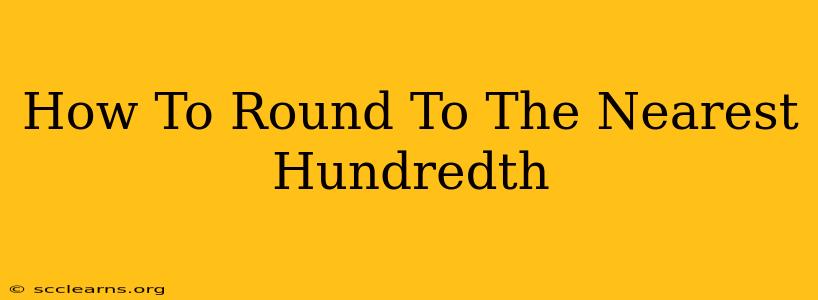Rounding numbers is a fundamental skill in mathematics used to simplify numbers while minimizing the loss of accuracy. This guide focuses specifically on how to round to the nearest hundredth, a common task in various fields, from finance to science. Understanding this process will improve your accuracy and efficiency in calculations.
Understanding Hundredths
Before diving into the rounding process, let's clarify what a hundredth represents. A hundredth is one part of one hundred (1/100). In decimal form, it's represented as 0.01. Rounding to the nearest hundredth means finding the closest number with only two digits after the decimal point.
The Rounding Process: Step-by-Step Guide
Rounding to the nearest hundredth involves these steps:
-
Identify the hundredths digit: Locate the digit in the hundredths place (two places to the right of the decimal point).
-
Look at the thousandths digit: This is the digit immediately to the right of the hundredths digit (three places to the right of the decimal point).
-
Round up or down:
-
If the thousandths digit is 5 or greater (5, 6, 7, 8, or 9), round the hundredths digit up. This means adding 1 to the hundredths digit. If the hundredths digit is 9, you'll need to carry-over the 1 to the tenths digit.
-
If the thousandths digit is less than 5 (0, 1, 2, 3, or 4), keep the hundredths digit as it is. Simply drop all digits to the right of the hundredths place.
-
Examples:
-
Rounding 3.14159 to the nearest hundredth:
- The hundredths digit is 4.
- The thousandths digit is 1 (less than 5).
- Therefore, we keep the 4, and the rounded number is 3.14.
-
Rounding 2.786 to the nearest hundredth:
- The hundredths digit is 8.
- The thousandths digit is 6 (greater than or equal to 5).
- Therefore, we round the 8 up to 9, resulting in 2.79.
-
Rounding 9.997 to the nearest hundredth:
- The hundredths digit is 9.
- The thousandths digit is 7 (greater than or equal to 5).
- We round the 9 up, resulting in 10. Since we can't have a two-digit number in the hundredths place, we carry the 1 over to the tenths place, giving us 10.00.
Practical Applications of Rounding to the Nearest Hundredth
Rounding to the nearest hundredth has many practical applications:
-
Finance: Calculating interest rates, displaying monetary values, and determining tax amounts often involve rounding to the nearest cent (hundredth of a dollar).
-
Science: Rounding measurements in experiments and recording data frequently uses the nearest hundredth to maintain precision without unnecessary complexity.
-
Engineering: Various calculations in engineering fields often require rounding to the nearest hundredth for accuracy in designs and estimations.
-
Everyday Life: Calculating tips, splitting bills, or measuring ingredients for recipes might involve rounding to the nearest hundredth for simplification.
Mastering the Skill
Consistent practice is key to mastering rounding to the nearest hundredth. Start with simple examples and gradually increase the complexity. Using a calculator can help you check your work, but try to perform the calculations manually to strengthen your understanding of the process. With enough practice, you'll be able to round numbers accurately and efficiently. Remember to always consider the context of the problem and the level of accuracy needed. Sometimes, rounding to a different place value may be more appropriate.

